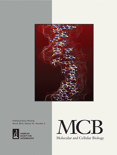
Cell Discovery
Scope & Guideline
Empowering Open Access to Cutting-Edge Research
Introduction
Aims and Scopes
- Cellular Mechanisms and Signaling:
The journal focuses on elucidating the fundamental cellular mechanisms and signaling pathways that govern cell behavior, development, and differentiation. - Cancer Biology and Therapeutics:
A significant portion of the research published addresses cancer biology, exploring mechanisms of tumorigenesis, metastasis, and therapeutic strategies including immunotherapy and targeted treatments. - Stem Cell Research and Regenerative Medicine:
Cell Discovery covers advancements in stem cell biology, including differentiation, applications in regenerative medicine, and the role of stem cells in development and disease. - Genomics and Epigenetics:
Research on the genomic and epigenetic regulation of gene expression, including studies on CRISPR technology and epigenetic editing, is a core focus of the journal. - Microbiome and Host Interactions:
The journal includes studies that investigate the interactions between microbiota and host cells, particularly how these relationships influence health outcomes. - Structural Biology:
Cell Discovery features structural insights into proteins and complexes that play vital roles in cellular processes, enhancing our understanding of cellular function at the molecular level.
Trending and Emerging
- Single-Cell Omics Technologies:
There is a rising trend in the use of single-cell sequencing and multi-omics approaches to dissect cellular heterogeneity and understand complex biological systems, particularly in cancer and developmental biology. - CRISPR and Genome Editing Innovations:
Research involving CRISPR and other genome editing technologies is gaining momentum, with studies focusing on novel applications in gene therapy and functional genomics. - Immunotherapy and Cancer Treatment Advances:
A significant increase in studies related to immunotherapy strategies, particularly CAR T-cell therapies and novel checkpoint inhibitors, reflects the growing interest in harnessing the immune system to combat cancer. - Microbiome Research and Health Implications:
Emerging studies are increasingly focusing on the microbiome's role in health and disease, exploring its impact on immune responses, metabolism, and overall cellular function. - Artificial Intelligence in Biomedical Research:
The integration of artificial intelligence and machine learning techniques to analyze large datasets and predict biological outcomes is becoming a prominent theme in recent publications.
Declining or Waning
- Conventional Virology Studies:
Research focusing solely on traditional virology methods appears to be decreasing, particularly as more emphasis is placed on innovative approaches such as structural biology and computational modeling. - Basic Cell Culture Techniques:
There is a noticeable decline in publications centered around basic cell culture methodologies, as the field increasingly prioritizes advanced techniques such as single-cell analysis and organoid models. - Animal Models for Disease Research:
Utilization of traditional animal models is becoming less common, as researchers explore more sophisticated systems such as organoids and humanized models that better mimic human disease.
Similar Journals

Life Science Alliance
Championing Excellence in Open Access Publishing.Life Science Alliance, published by LIFE SCIENCE ALLIANCE LLC, is a premier open access journal that has been making significant contributions to the fields of Biochemistry, Genetics and Molecular Biology, Ecology, Health, Toxicology and Mutagenesis, and Plant Science since its inception in 2018. With an impressive ranking in Scopus, including Q1 quartile positions and high percentiles in relevant categories, this journal is a vital resource for researchers, professionals, and students alike who seek to advance knowledge and innovation in life sciences. The journal operates on an open access model, ensuring that research findings are freely available to the global scientific community, thereby enhancing the visibility and impact of published work. With a commitment to fostering collaboration and disseminating high-quality research, Life Science Alliance serves as an essential platform for the promotion and exchange of scientific knowledge, aiming to bridge gaps and stimulate discussions across multiple disciplines.

Protein & Cell
Fostering Global Knowledge Exchange in Biochemical ResearchProtein & Cell, published by Oxford University Press, is a distinguished international journal focusing on cutting-edge research in the fields of biochemistry, biotechnology, cell biology, and drug discovery. This open access journal, active since 2014, is dedicated to disseminating innovative findings that advance our understanding of protein functions and cellular processes, making it an essential resource for researchers, professionals, and students alike. With an impressive 2023 impact factor reflected in its Q1 ranking across multiple categories such as Biochemistry, Drug Discovery, and Cell Biology, 'Protein & Cell' stands at the forefront of scientific research, driving collaboration and discussion in the scientific community. Researchers can access the journal freely online, fostering a global exchange of knowledge and contributing to significant advancements in medicine and biotechnology. Located in the United Kingdom, the journal strives to be a pivotal platform for impactful research that influences future studies and applications.

CELL PROLIFERATION
Fostering Discoveries that Transform BiotechnologyCELL PROLIFERATION, published by Wiley, is a leading open-access journal that has been at the forefront of research since its inception in 1968. With an impact factor that solidifies its position in the Q1 category of both Cell Biology and Medicine (Miscellaneous), this journal serves as a premier platform for disseminating groundbreaking studies in the field of cellular and molecular biology. The journal is renowned for its rigorous peer-review process and comprehensive coverage of topics related to cell growth, division, and differentiation, making it an invaluable resource for researchers, professionals, and students alike. With its notable Scopus ranking of #30 in Biochemistry, Genetics, and Molecular Biology: Cell Biology, and a robust open access model since 2019, CELL PROLIFERATION ensures that cutting-edge research is accessible to a global audience, fostering collaboration and innovation across the scientific community. Located in the United Kingdom, the journal remains committed to enhancing the understanding of cellular processes, thereby influencing developments in medicine and biotechnology.

DNA AND CELL BIOLOGY
Empowering Scientific Progress Through Rigorous ResearchDNA AND CELL BIOLOGY, published by Mary Ann Liebert, Inc, is a distinguished journal in the realms of cell biology, genetics, and molecular biology, holding a notable position in its Q3 and Q2 quartile rankings across multiple academic categories as of 2023. With an ISSN of 1044-5498 and an E-ISSN of 1557-7430, this journal has been a pivotal platform for the dissemination of cutting-edge research since its inception in 1990, extending its coverage through 2024. Situated in the United States, the journal offers high-quality peer-reviewed articles, exploring significant advancements in biological sciences while fostering interdisciplinary collaborations within the research community. Though it currently does not offer open access, subscribed institutions and individual readers benefit from its rich repository of knowledge. The journal's rigorous standards and impactful content make it an essential resource for researchers, professionals, and students alike, aiming to stay at the forefront of discoveries influencing DNA and cellular dynamics.

CELL DEATH AND DIFFERENTIATION
Illuminating the Pathways of Cellular TransformationCELL DEATH AND DIFFERENTIATION, published by SpringerNature, is a leading peer-reviewed journal that has been at the forefront of advancing knowledge in the fields of cell biology and molecular biology since its inception in 1994. With an impressive impact factor and ranking in the Q1 quartile for both categories as of 2023, it is recognized as an essential resource for researchers and professionals dedicated to understanding the intricate processes of cellular death and differentiation. The journal publishes high-quality original research articles, reviews, and commentaries, fostering an interdisciplinary dialogue among scientists exploring the molecular mechanisms that underpin these fundamental biological processes. With its commitment to excellence, CEL DEATH AND DIFFERENTIATION bridges gaps in knowledge and stimulates innovation within the scientific community. To access cutting-edge research from this prestigious journal, you may visit their website for subscription options and explore a wealth of knowledge that is crucial for advancing the frontiers of biological research.

Genes & Diseases
Shedding light on the genetic foundations of disease.Genes & Diseases, published by KEAI PUBLISHING LTD, is a premier open-access journal dedicated to advancing the fields of genetics, biochemistry, and molecular biology. Established in 2014 and headquartered in Beijing, China, this journal has quickly risen to prominence, securing a place in the prestigious Q1 quartile in Biochemistry and Genetics (clinical), as well as Q2 in Cell Biology and Q1 in Molecular Biology as of 2023. With a commitment to disseminating cutting-edge research, Genes & Diseases serves as a critical platform for researchers, professionals, and students alike, ensuring that high-quality scientific work is openly accessible to the global community. The journal's exceptional impact is underscored by its selective Scopus rankings, which reflect its influence and relevance in key scientific domains, making it an essential resource for those exploring the intersections of genetics and disease pathology.

Cell Reports
Unlocking Innovations in Biochemistry and GeneticsCell Reports is a prestigious open-access journal published by CELL PRESS that has firmly established itself as a leading voice in the fields of Biochemistry, Genetics, and Molecular Biology. Since its inception in 2012, the journal has provided an innovative platform for rapid dissemination of cutting-edge research, ensuring that high-quality findings are accessible to a global audience. With an impressive impact factor and ranking within the top 10% in its category, as reflected by its Q1 ranking in Scopus, Cell Reports serves a vital role in advancing scientific knowledge and fostering collaboration among researchers. The journal's commitment to the open-access model not only enhances visibility but also encourages the sharing of critical advancements in molecular biology. Situated in the Netherlands, its contributions are recognized worldwide, making Cell Reports an indispensable resource for scientists aiming to stay at the forefront of their fields and facilitate breakthroughs that may shape the future of biomedicine.

CELL RESEARCH
Connecting Research to Real-World ImpactCELL RESEARCH is a premier peer-reviewed journal dedicated to advancing the field of cell biology and molecular biology, published by SpringerNature. With an impressive impact factor and consistently ranking in the Q1 quartile for both cell biology and molecular biology, this journal serves as a pivotal resource for researchers, professionals, and students seeking to explore the latest discoveries and advancements in cellular mechanisms and their implications for health and disease. Since its inception in 1996, CELL RESEARCH has cultivated a distinguished reputation, currently boasting ranks in the top percentile of Scopus categories, reaffirming its influence and relevance to the scientific community. Although it is not an Open Access journal, its rigorous selection process ensures the publication of high-quality articles that contribute significantly to our understanding of life sciences. For those deeply engaged in the realms of biochemistry, genetics, and molecular biology, CELL RESEARCH is an essential conduit of innovative research and critical insights.

JOURNAL OF CELLULAR BIOCHEMISTRY
Transforming Knowledge into Breakthroughs in Cellular BiochemistryJournal of Cellular Biochemistry is a premier academic journal dedicated to advancing the field of biochemistry and cellular biology. Published by Wiley, this influential journal has a significant impact factor that underscores its relevance and authority within the scientific community. With its ISSN 0730-2312 and E-ISSN 1097-4644, the journal has been on the frontier of research since its inception in 1982, and is expected to continue publishing cutting-edge studies through 2024. As evidenced by its ranking in the 2023 Scopus Quartiles, it holds a rank of Q2 in Biochemistry and Q3 in both Cell and Molecular Biology, placing it among the top tiers of scientific journals in these disciplines. The Journal of Cellular Biochemistry serves as a vital resource for researchers, professionals, and students alike, providing a platform for the dissemination of innovative ideas and findings that shape our understanding of cellular processes and biochemical pathways. Though it does not currently offer Open Access options, its robust peer-review process ensures that each publication meets the highest academic standards, thus solidifying its esteemed position in the landscape of biochemical research.

MOLECULAR AND CELLULAR BIOLOGY
Driving Innovation in Molecular and Cellular ScienceMOLECULAR AND CELLULAR BIOLOGY, published by TAYLOR & FRANCIS INC, stands as a preeminent platform for researchers, professionals, and students engaged in the dynamic field of molecular and cellular biology. Established in 1981 and ongoing into 2024, the journal features cutting-edge research that spans across vital sub-disciplines, garnering a strong impact in its contributions to the scientific community. With an impressive Q2 ranking in Cell Biology and Q1 ranking in Molecular Biology for 2023, it consistently publishes high-quality articles that reflect the latest advancements and discoveries within the field. The journal is particularly well-regarded for its rigorous peer-review process and commitment to scientific excellence, making it an invaluable resource for those seeking to deepen their understanding of molecular mechanisms and cellular processes. Although not open access, the journal offers diverse access options for researchers to reach the latest findings. By maintaining a strong focus on biochemistry, genetics, and molecular biology, MOLECULAR AND CELLULAR BIOLOGY remains essential reading for anyone looking to contribute to or stay informed about significant developments within this pivotal area of study.